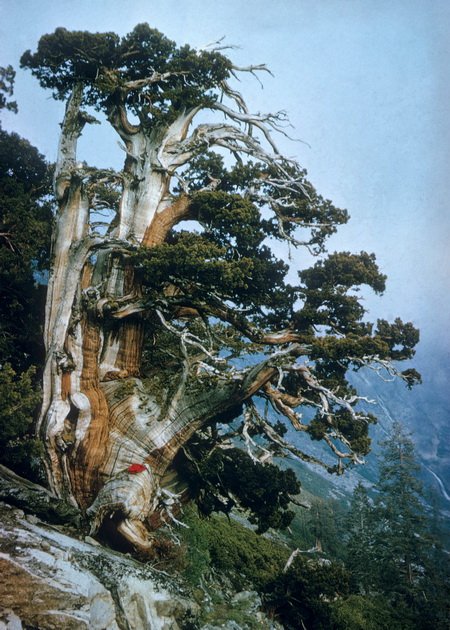 Populations of whitebark pine (Pinus albicaulis) are declining throughout most of the species range because of high levels of mortality from the exotic fungal pathogen (Cronartium ribicola) that causes the disease white pine blister rust in five-needle pines, and periodic upsurges of the endemic mountain pine beetle (Dendroctonus ponderosae). The absence of fire in some forests has also led to advanced succession of shade-tolerant species and subsequent reductions in whitebark pine. Finally, increased atmospheric warming and associated effects from altered precipitation patterns further threaten to reduce the geographic distribution of the species.
Populations of whitebark pine (Pinus albicaulis) are declining throughout most of the species range because of high levels of mortality from the exotic fungal pathogen (Cronartium ribicola) that causes the disease white pine blister rust in five-needle pines, and periodic upsurges of the endemic mountain pine beetle (Dendroctonus ponderosae). The absence of fire in some forests has also led to advanced succession of shade-tolerant species and subsequent reductions in whitebark pine. Finally, increased atmospheric warming and associated effects from altered precipitation patterns further threaten to reduce the geographic distribution of the species.
Precipitous declines in whitebark pine have cascading effects throughout the ecosystem primarily because of the subalpine and treeline positions the species occupies. When forest stands succumb to mortality, few if any other species exist to fill the structural and functional roles of whitebark pine. Notably, whitebark pine presence dampens snow melt, stabilizes soils, provides cover and birthing habitat, and its seeds are highly nutritious and consumed by a wide array of vertebrate species.
For over thirty years researchers and managers have sought to understand whitebark pine ecology, and to devise and implement procedures to reduce population decline and restore these valuable high-elevation ecosystems. The documents presented in this Hot Topic are a collection of the key contributions from this effort.
This hot topic was developed in partnership with the Fire Effects Information System.
Recorded Webinars
Research Briefs
- Fuel Treatments in Whitebark Pine Forests: Limiting Whitebark Pine Mortality During Burning
- Whitebark pine growth and defense in response to mountain pine beetle outbreaks
- Predicting the future to save whitebark pine
- Conserving whitebark pine in ski areas - Demonstrations at Whitefish Mountain Resort
- Whitebark pine restoration challenges - Restoration site visits in the Bridger Mountains
Conference Proceedings
- The future of high-elevation, five-needle white pines in western North America: Proceedings of the High Five Symposium. 28-30 June 2010; Missoula, MT
- Whitebark pine guidelines for planting prescriptions
- Comparing historic and modern forests on the Bitterroot Front
- Proceedings-symposium on whitebark pine ecosystems: Ecology and management of a high-mountain resource
Technical Reports/White Papers
- Effects of climate change and climate-altered fire regimes on whitebark pine populations
- Guidelines and Best Practices for Managing Fire in Whitebark Pine Stands in the Crown of the Continent
- Fire history and fire-climate interactions in high elevation whitebark pine dominated forest
- Conservation and management of whitebark pine ecosystems
- A 20-year reassessment of the health and status of whitebark pine forests in the Bob Marshall Wilderness Complex, Montana
- Whitebark pine workshop: science, management, and community
- A range-wide restoration strategy for whitebark pine (Pinus albicaulis)
- Management guide to ecosystem restoration treatments: whitebark pine forests of the Northern Rocky Mountains, U.S.A.
- Whitebark pine diameter growth response to removal of competition
- Whitebark pine in peril: a case for restoration
Publications
2024
2022
2021
2020
2019
2018
2017
2016
2015
2012
2010
2009
2001
Podcasts
Presentations
Past Events
- Oct 7, 2025
- Sep 14, 2022
- Oct 5, 2021
- Sep 16, 2020
- Sep 13, 2019
- Sep 20, 2018
- Nov 7, 2017
- Sep 16, 2016
- Mar 15, 2016
- Oct 1, 2015
- Sep 18, 2015
- Sep 16, 2015
- Sep 20, 2013